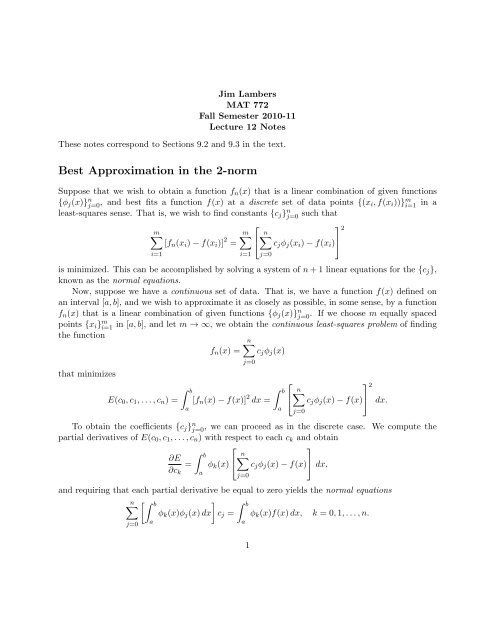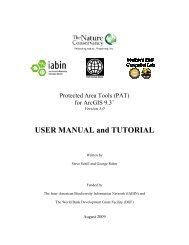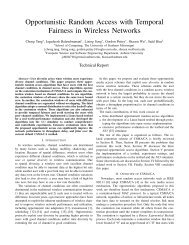Best Approximation in the 2-norm
Best Approximation in the 2-norm
Best Approximation in the 2-norm
- No tags were found...
You also want an ePaper? Increase the reach of your titles
YUMPU automatically turns print PDFs into web optimized ePapers that Google loves.
Then, we say f and g are orthogonal with respect to this <strong>in</strong>ner product if ⟨f, g⟩ = 0.In general, an <strong>in</strong>ner product on a vector space V over R, be it cont<strong>in</strong>uous or discrete, has <strong>the</strong>follow<strong>in</strong>g properties:1. ⟨f + g, h⟩ = ⟨f, h⟩ + ⟨g, h⟩ for all f, g, h ∈ V2. ⟨cf, g⟩ = c⟨f, g⟩ for all c ∈ R and all f ∈ V3. ⟨f, g⟩ = ⟨g, f⟩ for all f, g ∈ V4. ⟨f, f⟩ ≥ 0 for all f ∈ V, and ⟨f, f⟩ = 0 if and only if f = 0.This <strong>in</strong>ner product can be used to def<strong>in</strong>e <strong>the</strong> <strong>norm</strong> of a function, which generalizes <strong>the</strong> conceptof <strong>the</strong> magnitude of a vector to functions, and <strong>the</strong>refore provides a measure of <strong>the</strong> “magnitude” ofa function. Recall that <strong>the</strong> magnitude of a vector v, denoted by ∥v∥, can be def<strong>in</strong>ed by∥v∥ = (v ⋅ v) 1/2 .Along similar l<strong>in</strong>es, we def<strong>in</strong>e <strong>the</strong> 2-<strong>norm</strong> of a function f(x) def<strong>in</strong>ed on [a, b] by(∫ b1/2∥f∥ 2 = (⟨f, f⟩) 1/2 = [f(x)] dx) 2 .As we will see, it can be verified that this function does <strong>in</strong> fact satisfy <strong>the</strong> properties required of a<strong>norm</strong>. The cont<strong>in</strong>uous least-squares problem can <strong>the</strong>n be described as <strong>the</strong> problem of f<strong>in</strong>d<strong>in</strong>gsuch thatf n (x) =(∫ b∥f n − f∥ 2 =aan∑c j φ j (x)j=0) 1/2[f n (x) − f(x)] 2 dxis m<strong>in</strong>imized. This m<strong>in</strong>imization can be performed over C[a, b], <strong>the</strong> space of functions that arecont<strong>in</strong>uous on [a, b], but it is not necessary for a function f(x) to be cont<strong>in</strong>uous for ∥f∥ 2 to bedef<strong>in</strong>ed. Ra<strong>the</strong>r, we consider <strong>the</strong> space L 2 (a, b), <strong>the</strong> space of real-valued functions such that ∣f(x)∣ 2is <strong>in</strong>tegrable over (a, b).One very important property that ∥ ⋅ ∥ 2 has is that it satisfies <strong>the</strong> Cauchy-Schwarz <strong>in</strong>equality∣⟨f, g⟩∣ ≤ ∥f∥ 2 ∥g∥ 2 ,f, g ∈ V.This can be proven by not<strong>in</strong>g that for any scalar c ∈ R,c 2 ∥f∥ 2 2 + 2c⟨f, g⟩ + ∥g∥ 2 2 = ∥cf + g∥ 2 2 ≥ 0.4
The left side is a quadratic polynomial <strong>in</strong> c. In order for this polynomial to not have any negativevalues, it must ei<strong>the</strong>r have complex roots or a double real root. This is <strong>the</strong> case if <strong>the</strong> discrimantsatisfies4⟨f, g⟩ 2 − 4∥f∥ 2 2∥g∥ 2 2 ≤ 0,from which <strong>the</strong> Cauchy-Schwarz <strong>in</strong>equality immediately follows. By sett<strong>in</strong>g c = 1 and apply<strong>in</strong>g this<strong>in</strong>equality, we immediately obta<strong>in</strong> <strong>the</strong> triangle-<strong>in</strong>equality property of <strong>norm</strong>s.Suppose that we can construct a set of functions {φ j (x)} n j=0 that is orthogonal with respect to<strong>the</strong> <strong>in</strong>ner product of functions on [a, b]. That is,⟨φ k , φ j ⟩ =∫ baφ k (x)φ j (x) dx ={ 0 k ∕= jα k > 0 k = j .Then, <strong>the</strong> <strong>norm</strong>al equations simplify to a trivial system[∫ b][φ k (x)] 2 dx c k =a∫ baφ k (x)f(x) dx,k = 0, 1, . . . , n,or, <strong>in</strong> terms of <strong>norm</strong>s and <strong>in</strong>ner products,∥φ k ∥ 2 2c k = ⟨φ k , f⟩,k = 0, 1, . . . , n.It follows that <strong>the</strong> coefficients {c j } n j=0 of <strong>the</strong> least-squares approximation f n(x) are simplyc k = ⟨φ k, f⟩∥φ k ∥ 2 , k = 0, 1, . . . , n.2If <strong>the</strong> constants {α k } n k=0 above satisfy α k = 1 for k = 0, 1, . . . , n, <strong>the</strong>n we say that <strong>the</strong> orthogonalset of functions {φ j (x)} n j=0 is ortho<strong>norm</strong>al. In that case, <strong>the</strong> solution to <strong>the</strong> cont<strong>in</strong>uous least-squaresproblem is simply given byc k = ⟨φ k , f⟩, k = 0, 1, . . . , n.Next, we will learn how sets of orthogonal polynomials can be computed.5
















